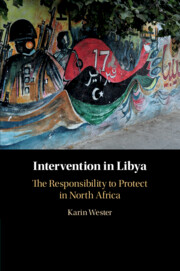Book contents
- Intervention in Libya
- Intervention in Libya
- Copyright page
- Dedication
- Epigraph
- Contents
- Preface
- Maps
- Introduction
- 1 The Origin of the Responsibility to Protect
- 2 Authority Based on Protection in a Historical Context
- 3 Libya and the Era of Qadhafi’s Rule
- 4 The Libyan Uprising and the International Response, February 15–26, 2011
- 5 The Libyan Uprising and the International Response, February 26–March 17, 2011
- 6 Operation Odyssey Dawn
- 7 Operation Unified Protector, NATO, and the UN
- 8 A Divided International Community Confronts a Divided Libya
- 9 Lessons to Be Learned
- Epilogue
- Select Bibliography
- Index
6 - Operation Odyssey Dawn
Published online by Cambridge University Press: 28 February 2020
- Intervention in Libya
- Intervention in Libya
- Copyright page
- Dedication
- Epigraph
- Contents
- Preface
- Maps
- Introduction
- 1 The Origin of the Responsibility to Protect
- 2 Authority Based on Protection in a Historical Context
- 3 Libya and the Era of Qadhafi’s Rule
- 4 The Libyan Uprising and the International Response, February 15–26, 2011
- 5 The Libyan Uprising and the International Response, February 26–March 17, 2011
- 6 Operation Odyssey Dawn
- 7 Operation Unified Protector, NATO, and the UN
- 8 A Divided International Community Confronts a Divided Libya
- 9 Lessons to Be Learned
- Epilogue
- Select Bibliography
- Index
Summary
Chapter 6 examines how the responsibility to protect was implemented after the Security Council adopted resolution 1973 and focuses specifically on the questions of if and when peaceful means were considered to be inadequate, and of how and by whom collective action should be taken. A reconstruction and analysis of Operation Odyssey Dawn, the military operation that France, the United Kingdom, and the United States began on March 19, 2011, demonstrate that the original unity displayed by the international community in its response to the Libyan crisis entirely evaporated by the time military force was employed in order to implement resolution 1973. Within three days, the coalition largely established a no-fly zone over Libya, and a variety of sources indicate that a massacre was most likely prevented. Yet, Operation Odyssey Dawn provoked sharp criticism and the United States, the United Kingdom, and France also faced considerable difficulties in agreeing on the future direction of the operation in Libya. Only after intense diplomatic efforts was NATO able to take over command and control of all operations in Libya by the end of March 2011.
Keywords
- Type
- Chapter
- Information
- Intervention in LibyaThe Responsibility to Protect in North Africa, pp. 186 - 212Publisher: Cambridge University PressPrint publication year: 2020
- 1
- Cited by



